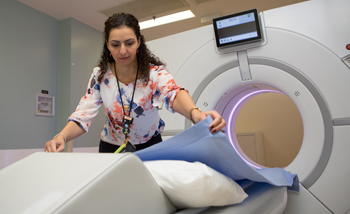Speedy CT scanner can cut radiation doses in half

By James Wysotski

CT operations leader Shadi Mossaed sets up the GE Revolution CT scanner. (Photo by Katie Cooper)
Even before 2017 upgrades are complete, the speed of St. Michael’s Hospital’s newest computerized tomography, or CT, scanner has revolutionized the treatment of patients.
A CT or CAT scan is a diagnostic medical test that produces multiple images of the inside of the body by making use of many computer-processed combinations of X-rays taken from different angles to produce cross-sectional (tomographic) images (virtual “slices”) of a specific body part.
Installed in fall 2015, the GE Revolution CT scanner will soon acquire images from a full rotation in 0.2 seconds, significantly faster than our other scanners according to CT operations leader Shadi Mossaed. The increased speed means agitated patients who move in the bore rarely cause blurry images, resulting in far fewer wasted scans.
“Before we would have to scan several cardiac cycles and then the scanner would combine the image data to get one clear picture of all the cardiac anatomy,” said Mossaed. “But now because it’s so fast, we can get all of that information in one rotation with very little motion and at one-quarter of the dose.”
Adding to the efficiency is a wider detector that increases scans from 4 cm to 16 cm, meaning 256 slices instead of 64. Faster than the blink of an eye, one rotation can now capture an entire head. As a result, Mossaed said patients undergoing head scans are on the machine for a quarter of the usual time.
More importantly, with fewer, faster scans comes a dramatic radiation dose reduction.
“We’ve been working hard on reducing doses,” said Dr. Tim Dowdell, radiologist-in-chief. “They had dropped by about 15 per cent even before getting the Revolution, and now we’ve noticed an even further drop of 25-60 per cent less radiation for body CT scans.”
“Because of the improved efficiency with the GE Revolution, we find we’re able to do other things such as spending more time with the patient.” – Shadi Mossaed, CT Operations Leader |
A 2017 upgrade will reduce the dose even further. New “dual energy” software will let one scan do the job of two by editing images to remove the effects of a contrast agent injected by IV into arteries to highlight blood vessels. Previously, a separate scan without the contrast agent was required to see coronary calcification.
Dr. Dowdell said that by dose, the images are better. They’re clearer because the Revolution causes less blur and gets rid of noise and artifacts – interference caused by metal in the body.
“We now use a lot less radiation to get quality images,” said Dr. Dowdell. “And that’s great for patients because we’re looking for pictures that answer clinical questions at the lowest possible dose.”
About St. Michael’s Hospital
St. Michael’s Hospital provides compassionate care to all who enter its doors. The hospital also provides outstanding medical education to future health care professionals in 27 academic disciplines. Critical care and trauma, heart disease, neurosurgery, diabetes, cancer care, care of the homeless and global health are among the hospital’s recognized areas of expertise. Through the Keenan Research Centre and the Li Ka Shing International Healthcare Education Centre, which make up the Li Ka Shing Knowledge Institute, research and education at St. Michael’s Hospital are recognized and make an impact around the world. Founded in 1892, the hospital is fully affiliated with the University of Toronto.
